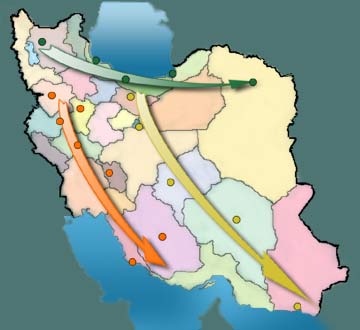| |
Touristic
villages network project in Iran |
| |
What is touristic village?
Touristic village is places of a province where
these places or near these places have natural, cultural and
historical attractions for tourists and these places need some
touristic facilities, feasibilities and also suitable information for
tourism. Touristic village is a center for local and international
tourists for interstate, vocational and residing journeys to different
tourism attractions in all over the state and it can be a center for
residing and distributing the tourists in each province. So these
centers must have all requirements and specifications for the tourists
and those who spend their leisure time there. So building
entertainment, sport, and residing, services, commercial and welfare
spaces, which must conforming to international standards is
anticipated for these places. Observing all ecological regards and
constant development are other specifications that must be considered
in the proposed plans. In this case we can have this confidence that
these villages can have suitable output both economical and cultural.
In the view point of the executors the best results of creating such
villages can be achieved through following the strategies which their
interest are directly referred to partners who are involved in
creating, developing and accomplishing necessary works. This can be
achieved through intelligent administrative and managerial systems.
The goals that considered for the touristic villages are:
High quality of residing and life
Safe economy
Stability of environment
National and international popularity |
| |
Why touristic villages?
In the past two decades, the status of developing tourism shows that
it is not possible to provide all urban spaces of province for
accepting tourists and creating suitable places for security and
relaxation of tourists, at least in future decade, so the bets and
trusty way is to centralize the tourists in on area which have the
more suitable facilities.
The aims of creating touristic villages |
| |
1- Increasing the number of the province
tourists
2- Increasing the public revenue by developing tourism
3- Increasing the jib opportunity
4- Activating the potential capacity of tourism in provinces of
country
|
5- Attracting private sector partnership in
developing tourism
6- Increasing investing capital
7- Promoting the public services to tourists
|
| |
Investment opportunities in villages
Due to the function of most of the touristic
villages creating the following sections and plans in the villages’
projects are implemented:
|
| |
The residential, receptional and service
centers
Hotel
Motel
Residential villas complex
Restaurants
The required services for residents (travel agencies and shopping
centers)
Cultural centers
Cinemas and theaters
Halls |
Entertaining centers
Sport spaces
Recreational clubs
Playgrounds for children
Recreational centers in jungles and picnic
Special routes for horse riding and cycling
Aquatic exercises
Coast facilities and
Recreational dock
Parks
|
| |
The axels of villages in Iran |
| |
By defining a network of touristic villages
which can have standard and coordinated services tourism areas
organization tries to have permanent customers for its projects. This
net work has been formed in three axis if ALBORZ, ZAGROS and KAVIR
that each one has its special specification.
KAVIR axel: Passes through ISFAHAN, YAZD, KERMAN provinces and the two
big deserts of “DASHTE KAVIR” and “LOUT KAVIR”, it is actually passing
through the northwestern-southeastern axis that is a path between
Europe to Pakistan and India. It is anticipated that this path will
have more attraction for the European tourists.
ZAGROS axel: A route in Iran north -south altitude which names ZAGROS
and it passes through the KORDESTAN, KERMANSHAH, LORESTAN, CHAHAR
MAHAL,FARS and BOUSHEHR provinces and it has specific attractions of
Iran’s native-tribes life.
ALBORZ axel: A route in east –west altitude of Iran which names ALBORZ
and it passes through the AZARBAYJAN,GILAN,MAZANDARAN, GOLESTAN and
KHIORASAN and currently has the main portion in Iran’s local tourism
and more than 20 million people pass through this route yearly. |
 |
| |
|